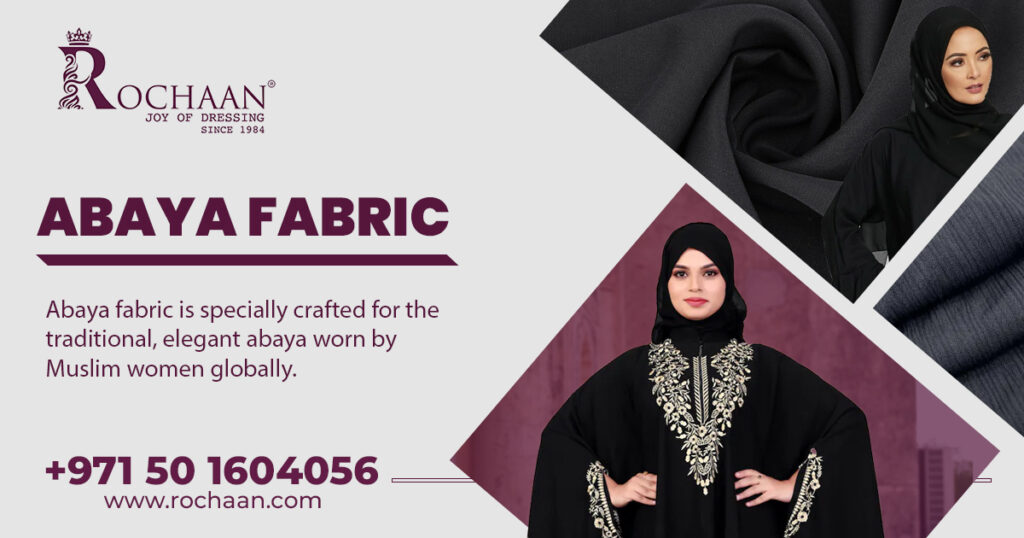Abaya fabric is made especially for the classic abaya, a long, graceful robe worn by many Muslim women worldwide. With its flowing pattern, this full-length fabric covers the entire body from the shoulders to the feet. The primary purpose of the abaya is to conform to cultural and traditional wears while providing modesty and grace. Its purpose is to keep the wearer looking dignified by being worn over other attire.

Types and Qualities of Abaya Fabrics
The fabric selection, comfort, and longevity influence the abaya’s overall aesthetic appeal.
Nylon:
Nylon is a common material choice for abayas due to its lightweight, durability, and wrinkle resistance. Because of its tenacity, the abaya is both long-lasting and convenient, keeping its shape and appearance even after frequent use. Nylon blends style and functionality for everyday purposes, making it perfect with abaya fabric.
Polyester:
Polyester is a reasonably priced fabric well known for not shrinking or stretching. Because of the fabric’s resilience, the abaya will last long and hold its shape over time, offering reliable functionality and a well-maintained appearance.
Cotton:
Cotton is well known for being supple, breathable, and comfortable. Its ease of cleaning makes it suitable for daily use. The fabric’s inherent qualities ensure easy maintenance and comfort, making it a fabric of choice for those who value convenience and comfort equally.
Silk:
Silk is renowned for being wealthy, glossy, and smooth. This cloth is an excellent option for special occasions, adding an exquisite touch to the abaya’s design. Its sumptuous texture and elegant appearance elevate an abaya fabric overall elegance, advance a dash of glitter to formal occasions.
Chiffon:
This flowing and delicate fabric is ideal for giving the abaya a gentle and ethereal feel. It is low-weight, guarantees comfort, and adds to the attractive, flowing form. Since chiffon is sheer and perfect for layering.
3. Factors to keep on mind When Choosing Abaya Fabric
Climate
Hot Weather: breathable fabrics like cotton or chiffon to stay calm and comfortable in changing weather.
Cold Weather: Consider heavier fabrics such as polyester or crepe for added warm to your body.
Occasion
Daily Wear: Durable abaya fabric like polyester or nylon are the best choice for everyday use, offering utility and long-term use.
Special Events: Luxurious fabrics such as silk are perfect for formal occasions, providing an elegant and formal look.
Comfort
Softness: Fabrics like cotton and silk offer excellent comfort with their soft textures.
Breath: To make sure comfort throughout the day, choose fabrics that allow good airflow, such as cotton or chiffon.
Maintenance
Easy Care: Polyester and nylon are low-maintenance options, requiring less effort to keep them in good condition.
High Maintenance: Silk needs extra care. You must do a hand wash or dry clean to maintain its quality and appearance.
4. Popular Abaya Fabric Trends
Embroidered fabrics are perfect for formal occasions and feature decorative elements like embroidery or glitter. Printed fabrics offer new patterns that give classic designs a chic update. Combining several materials for a complex, eye-catching appearance, layered textiles add a distinctive sophistication and elegance to the abaya fabric.
5. Care Instructions for Abaya Fabrics
Nylon and polyester fabrics should be dried on low heat or left to air dry after being machine-washed in cold water. Cotton should be washed in warm water, dry in air and ironed if necessary to preserve quality. Silk and chiffon should be air-dried rather than hand-washed or dry-cleaned.
6. Choosing the Right Abaya Fabric for You
Before selecting an abaya cloth, evaluate your requirements by considering your use, taste, style, and functionality. The next thing to consider is your budget. Select reasonably priced textiles you can afford, thinking that pricier options may be more expensive but will still have more refinement and elegance.
Conclusion
Abaya fabric selection involves balancing comfort, usefulness, and style. To make the best choice, consider variables like weather, event, and upkeep requirements. Choosing the correct fabric for your abaya offers elegance and functionality, whether for everyday durability or luxurious styling for special occasions.
Related: What is the best fabric to make an abaya?
Frequently Asked Questions (FAQs)
1) Which material works best for an abaya in warm weather?
Breathable materials like cotton or chiffon are perfect for hot weather. They help you avoid overheating by letting air circulate, keeping you cool and comfortable.
2) How should I pick the fabric of my abaya for a special occasion?
Luxurious materials like silk or satin are ideal for special events. These materials give your abaya a refined and elegant look appropriate for formal occasions.
3) What kind of maintenance are some abaya materials in need of?
For polyester and nylon, tumble dry on low heat or air dry in a cold water machine wash.
Cotton: Iron if necessary, tumble dry on low heat, air dry, or machine wash in warm water.
Silk and chiffon: Do not wring; hand wash or dry clean, then let air dry.
